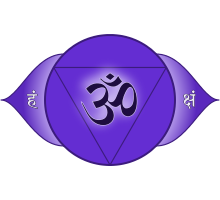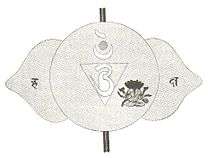Ajna
Ajna or Agya (Sanskrit: आज्ञा, IAST: Ājñā, IPA: [aːɟɲaː]) or Brow or third eye chakra, is the sixth primary chakra in the body according to Hindu tradition.[2][3][4] It is supposedly a part of the brain which can be made more powerful through meditation, yoga and other spiritual practices[5][6] just as a muscle is. In Hindu tradition, it signifies the subconscious mind, the direct link to the brahman. While a person's two eyes see the physical world, the third eye is believed to reveal insights about the future. The third eye chakra is said to connect people to their intuition, give them the ability to communicate with the world, or help them receive messages from the past and the future.[7][8][9][10][11]

| Tantric chakras |
|---|
Location
The Ajna chakra is located in the center of the forehead between the eyebrows. It is not a part of the physical body but considered to be the part of Pranic system. The location makes it a sacred spot where Hindus apply a vermilion bindi to show reverence for it. The Ajna chakra is correspondent with the pineal gland.
Appearance
Ajna is described as a transparent lotus flower with two white petals, said to represent the nadis (psychic channels) Ida and Pingala, which meet the central Sushumna nadi before rising to the crown chakra, Sahasrara. The letter "ham" (हं) is written in white on the left petal and represents Shiva, while the letter "ksham" (क्षं) is written in white on the right petal and represents Shakti.[12]
Inside the pericarp of the flower is the hakini Shakti. It is depicted with a white moon, six faces, and six arms holding a book, a skull, a drum, and a rosary, while making the gestures associated with granting boons and dispelling fears. The downward-pointing triangle above her contains a white lingam. This triangle, along with the lotus flower, can represent wisdom.[13] In some systems the deity Ardhanarishvara, a hermaphrodite form Shiva-Shakti, resides within the lingam and symbolizes the duality of subject and object. This sixth chakra of our energy body is also connected with the sixth layer of our aura, known as the celestial layer in aura science.
Seed syllable

The seed syllable of Ajna is Ksham and the more well known, Om, or "Pranava Om", which is believed to be the basic sound of the world and contains all other sounds. It is considered the supreme sound of the universe.[14] The Bīja mantras are monosyllabic seed sounds which, when they are spoken aloud, activate the energy of the chakras in order to purify and balance the mind and body. The energy resonates in the chakra associated with the mantra, helping the speaker become aware of their body's needs.[15]
Function
Ajna translates as "authority" or "command" (or "perceive") and is considered the eye of intuition and intellect. Its associated sense organ is the brain.[16][17][18]
See also
- Kundalini
- Pineal gland
- Parietal eye
- Third eye
References
- "The Ancient Powerful Practices of Hindu Meditation". The Way of Meditation. 2015-05-05. Archived from the original on 2018-09-22. Retrieved 2017-03-31.
- "Third Eye - A Thorough Explanation". Token Rock. Retrieved 2017-03-31.
- "The Third Eye and the Pineal Gland". Blavatsky Theosophy Group UK. 2014-03-05. Retrieved 2017-03-31.
- "Chakra Meditation For Deep Healing And Balancing". WellBeingAlignment. Retrieved 2017-03-31.
- Kilham, Christopher S. "Chakra Meditation to Increase Your Energy Flow". www.innerself.com. Retrieved 2017-03-31.
- "Ajna Chakra - The Third Eye Chakra - Sanskriti - Indian Culture". Sanskriti - Indian Culture. 2014-01-13. Retrieved 2017-03-31.
- www.wisdomlib.org (2014-02-27). "Ājñā, Ajna, Āgyā: 3 definitions". Wisdom Library. Retrieved 2017-03-31.
- "The Third Eye in Hinduism & Buddhism -". www.lotussculpture.com. Retrieved 2017-03-31.
- "The Seven Chakras and Their Significance". The Isha Blog. 2013-01-21. Archived from the original on 2015-05-26. Retrieved 2017-03-31.
- "Ajna Chakra – SivaSakti". sivasakti.com. Retrieved 2017-03-31.
- "Sixth Chakra Third Eye Chakra Ajna Chakra". My Chakras. 2008-05-27. Retrieved 2016-05-04.
- "The Third Eye Chakra". www.chakras.info. Retrieved 2016-04-29.
- "What Does Om Mean". www.sacredfunk.com. Archived from the original on 2016-04-26. Retrieved 2016-04-27.
- "Bija Mantras- The Sounds of the Chakras: LAM VAM RAM YAM HAM OM - ar-yoga". ar-yoga. 2011-10-11. Retrieved 2016-05-04.
- Thill, Scott (2013-03-22). "4 Things You Should Know About Your 'Third Eye'". AlterNet. Retrieved 2017-03-31.
- "Benefits of Opening The Third Eye | PsychicGurus.org". www.psychicgurus.org. Retrieved 2017-03-31.
- "6 Benefits of Opening Your Third Eye | Inner Outer Peace". 2015-10-30. Retrieved 2017-03-31.